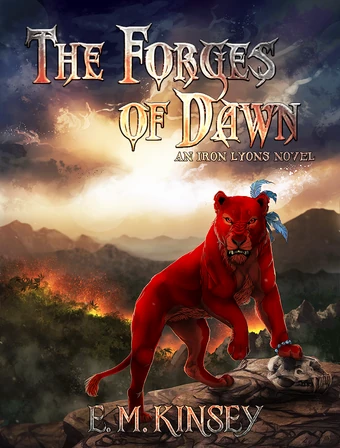 |
A fantasy xenofiction with magical talking lions. What's not to love? Let's have a look at this indie, The Forges of Dawn by E.M. Kinsey. Spoilers ahead.
The Forges of Dawn follows Uhuru, a blood-red lioness whose family is partially killed, partially taken away by a group of evil white lions known as the Pale Ones. She sets out on a rescue attempt, but ends up having to escape and save herself and one of her friends... who has been turned into a bloodthirsty monster. Uhuru ends up far away from her home in Afriik, where she now has to gather allies and learn how to fight and master magic in order to rescue her family and defeat the villain Vireka and his Pale One minions.
What can I say? This is to this day still my favorite indie published book I've read. Which, granted, isn't a whole lot, but this one is definitely one of my favorite books in general. Partially because it has everything I want in a story: fantasy and magic, xenofiction (particularly talking animals), a strong protagonist, a great journey, pirates, big cats, intimidating villains, interesting world building and cultures, it's all there. So no surprise that I like this, really. But, despite my bias for this book catering perfectly towards me, are there other reasons it's good? Let's see!
The world building, as already mentioned, is good. Taking place in an alternate version of planet Earth where humans never existed and animals evolved instead, this is a well-build world full of interesting lands, empires, kingdoms and cultures. A lot of it isn't even fully explored, probably setup for the sequel, but we're given enough not to feel like we're left hanging. I particularly liked the locations in Endia, from the Empire to the pirate island to Iz's pride home. All locations have a greatly different type of culture and way things work, which made everything feel distinct, rather than just variants of the same location. The concepts of the Tempest and Waste (a magically-caused storm and desert keeping strangers out of Afriik) were also very interesting, as was the world building and history regarding Mobor and Tsatsi.
The characters were rather good. I'm, of course, particularly impressed with Uhuru, who goes form your wide-eyed "I want to be a warrior" character to being broken and then re-forged into the hero of legend. She's just everything I like seeing in a good protagonist, so hats off to Kinsey for writing a good one. The other characters, however, are quite interesting, too. I particularly liked the tigress blacksmith Ming Huo, old Modak, deliciously smart and evil Yu Song and of course our secondary protagonist Tarute, who interestingly enough doesn't talk throughout most of the book yet still has a very clear personality and presence. Lochan is a character I couldn't quite get into, but he was still interesting, especially after one big deed he commits.
As for the villains, I already mentioned really liking the pirate tiger Yu Song, who is usually one step ahead of our protagonist. He wasn't the main villain here, but he still had an antagonistic role, and was clearly being set up as a major if not the main villain of book two. Yu Song was just a delight to read, and he had an... interesting dynamic with his crew, particularly his first mate. Our main villain in The Forges of Dawn, however, is Vireka, leader of the Pale Ones. While he is definitely the more standard big bad you'll often come across in fantasy, he's still interesting and very effective at his role. I wouldn't quite call him very memorable, but he does leave an impression. I also really appreciate the diversion of the "evil is dark/black" trope with him by having a white lion as villain instead.
There are some very minor nitpicks for me in this book. For one, the level of anthropomorphism is never quite made clear. When reading this before, I thought it was just the predator animals that had evolved to speak and become sentient, but I think it's implied that at least certain herbivores are, too, which may mean others are, too? Yet some predators keep herbivore animals as farm animals, which has some weird implications. I'd get it if it was just the predators, but having some herbivores like elephants and giraffes sentient too can be a bit weird. Wouldn't eating them (and by extension possibly other sentient herbivores) be considered cannibalism in a way?
Another very incredibly minor nitpick is that Uhuru later on wears a full lion skull as a mask, yet that's physically impossible (eye sockets aren't direct holes you can look through, they're rather hollowed-out spaces in the bone to accommodate eyeballs). I figured it'd be possible if the skull wasn't whole, but it's said that she literally looks like she has a skull for her head, so she'd have to figure out some impossible way to wear this. Again, incredibly nit-picky, but it's a big part of her presence and image during the climax. It does make for an awesome image, though, especially when combined with her wearing a white mane and glowing armor.
I also spotted some typos in this book, but, honestly, I've yet to encounter an indie I read that didn't have some error along these lines, so I'm not really holding it against the book.
So, yes, is it totally flawless? No, like I mentioned, it does have some tiny things wrong with it. However, the rest of the book is simply so awesome that I literally do not care. There's so much good stuff in here that it gets the best score from me. I'm looking forward towards the next Iron Lyons novel!
Rating: 5/5
No comments:
Post a Comment